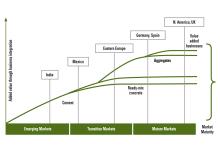
France is big and wealthy and has a correspondingly sizeable aggregates industry, driven by the globally renowned construction industry. Julie-Anne Ryan reports.
But while the country’s market has somewhat predictably not found itself in quite such dire straits as many smaller nations, the post-slump improvements seen less than two years ago have not continued, and many organisations are posting reduced circumstances.
Building and public works sectors weakened in the second quarter of this year. Municipal elections seemed to presage a further decrease in public sector orders, and the expected upturn in the residential building market has yet to materialise. So despite an overall huge increase in production compared to ten years ago, figures have fallen yet again year-on-year, albeit by a tiny percentage. Productivity per employee, and per hour, has increased slightly, which is a small boost for profitability.
| 2002 | 2011 | 2012 | %2012/2011 | |
|---|---|---|---|---|
| Turnover (in millions of €) | 2,856 | 3,851 | 3,802 | -1.3 |
| Number of firms | 1,800 | 1,570 | 1,550 | -1.3 |
| Workforce | 14,900 | 14,540 | 14,280 | -1.8 |
| Hours worked (in millions) | 18,800 | 16,730 | 16,570 | -1.0 |
| Productivity (Tonnes/Employee) (Tonnes/Hour) |
26,900 21.3 |
24,700 21.5 |
25,200 21.7 |
+2.0 +0.9 |
| Production per capita | 6.8 | 6.0 | 5.7 |
In monthly terms,
The aggregates sector was down 5.6% in May 2014 compared to May 2013.
There was a 3.4% increase in public works contracts carried out between April 2013 and April 2014, but the organisation confirmed that housing starts have gone down since the beginning of 2014, with a 20% drop in residential builds over the last three months.
According to Unicem, the economy is suffering from market distrust, lack of visibility in public funding, the relatively illegible housing policy and the reluctance of players to carry out investments.
| Production in 1,000s of tonnes |
Number of firms | Production in millions of tonnes |
Production % | |
|---|---|---|---|---|
| Loose rock | > 1000 | 21 | 47.7 | 34 |
| > 500 | 69 | 80.8 | 58 | |
| > 250 | 137 | 103.9 | 75 | |
| > 100 | 271 | 126.2 | 91 | |
| > 1 | 595 | 138.3 | 100 | |
| Limestone | > 1000 | 17 | 32.6 | 34 |
| > 500 | 44 | 50.1 | 52 | |
| > 250 | 105 | 71.7 | 74 | |
| > 100 | 212 | 89 | 92 | |
| > 1 | 426 | 96.9 | 100 | |
| Igneous | > 1000 | 18 | 44 | 40 |
| > 500 | 52 | 68 | 64 | |
| > 250 | 102 | 88 | 82 | |
| > 100 | 183 | 102 | 95 | |
| > 1 | 315 | 106 | 100 |
As the first table shows, there are 1,550 firms currently producing aggregates in France, from tiny independent limestone quarries in Limousin to huge global players such as
As positive news comes out from several of the organisations between the two extremes, it is important to note that one of the biggest mergers in any industry to be announced so far this year is that proposed between Lafarge and Holcim.
Disposals being planned by the two groups as part of anticipated competition authority rulings include Britain’s biggest cement maker,
Lafarge said it would pay at least £885million (€1.1 billion) to
Lafarge and Holcim will also sell assets in other markets including Austria, France, Germany and Hungary in order to smooth the regulatory passage of the £32 billion (€40 billion) merger.
Individually, Lafarge has posted another drop in quarterly sales and profit, saying this is mainly due to adverse exchange rates and its shrinking scale as it divests assets to trim its debt. The company’s earnings before interest, taxation, depreciation and amortisation (EBITDA) fell 2% to €812 million in the second quarter as sales fell 5% to €3.37 billion.
Bruno Lafont, chairman and CEO of Lafarge, said the company remained “fully mobilised on achieving our 2014 objective to generate more than €600 million thanks to our cost cutting and innovation actions, and aim at reducing our net debt below €9 billion by the end of the year.”
The proposed merger is set to be completed in the first half of 2015, he added, and pointed to Poland, Britain and Greece as countries showing improvement, although the construction sector remains subdued in France, weighing on aggregates and ready mixed volumes.
In other news, Cemex has opened a new €900,000 production plant near Branne in the south-west of France and it will replace the company’s plant in in Saint-Sulpice-de-Faleyrens in producing concrete for projects in Bordeaux.
Built on a 5,000m² plot, the new plant has a huge 360tonne granulate storage capacity with high security and environmental standards. It has ISO 14001 environmental management certification, as do all Cemex’s French plants.
The new plant is grey, rather than the otherwise ubiquitous Cemex white, so that it fits in with the area’s numerous historic monuments. Cemex has more than 330 production units across France.
Also Cemex has joined the Carbone Local Midi-Pyrénées initiative, which is aimed at allowing entities to offset their greenhouse gas emissions on a local scale: the scheme allows companies to earn Carbone Local credits from Ecocert (an organic certification organisation founded in France in 1991).
Before signing the agreement in June, Cemex contributed to the planting of 500 tree seedlings at its Cugnaux site.
And
A new aggregate import terminal under construction in Grattequina is said to have upset Unicem Aquitaine chairman Patrice Gazzarin.
The project needs a €13.7 million investment, primarily financed by local authorities.
Gazzarin was quoted in Le Moniteur des Travaux Publics et du Bâtiment saying that the project, designed to receive imports from Norway and Scotland, did not make sense from an environmental or economic point of view.
The imports required nine times the fossil fuel consumption that local quarries used, he said, and claimed that these authorities had failed to plan for a sustainable supply of aggregates in the area.
He added that resources in the Gironde region were being used up and not replaced. The replacement rate stands at around 2.5 million tonnes/year, compared to production of 6 million tonnes/year and consumption of 9 million tonnes/year.
This statement reflects the marked focus in France these days on the environment, and it is clearly reflected in the aggregates/construction industry.
Two years ago, the
It published its annual report and guidance documents on ecological land use planning and biodiversity. A study on the transport of aggregates was made to develop acceptability to the sector community, and the UNPG organised open door events in cooperation with all sectors of Unicem. The operation opened for guided visits at about 100 sites, and focused on topics such as life cycle, biodiversity and the quality of mineral resources. They also organised their National Sustainable Developments Awards Ceremony.
One recipient was the Cemex quarry in Ségrie, which received the Unicem environmental charter’s biodiversity mention, which recognises actions carried out by the quarry, and underlines its efforts in partnership with birds protection league LPO Sarthe to protect the yellow-bellied toad, which is in danger of becoming extinct in Pays de Loire. A birdhouse for peregrine falcons is soon set to be installed on the site.








